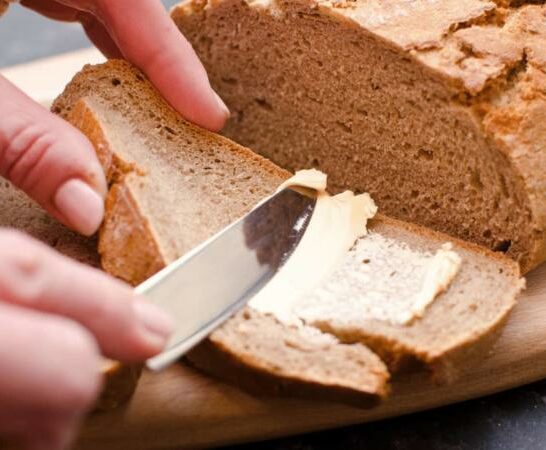While you are probably familiar with butter and margarine, it can be confusing when a recipe calls for baking spread.
Since this is a relatively new and uncommon term, you may be wondering what baking spread is and how to use it.
As you probably already figured, baking spread isn’t a fancy ingredient.
On the contrary, it’s pretty basic and can be easily found at your local grocery store. But what exactly is baking spread?
What is Baking Spread?
Baking spread is a butter substitute that is similar to margarine but is made from bovine fats and oils. It can be used in the same ways that you would normally use butter or margarine. In the US, many baking spreads are still made with vegetable oils.

What baking spread is used for
Baking spread was developed in the UK after a ban was enforced in the country on many of the ingredients in margarine, such as trans fats.
While margarine continues to be on grocery store shelves in the US, many British recipes now call for baking spread.
If you absolutely love the rich taste of butter or have always used margarine, you don’t necessarily need to hunt down a container of baking spread at your local grocery store.
It’s fine to use butter or margarine instead.
While the baking spread was created with the purpose of being a butter substitute, it’s not advised to use spreads in many recipes as it will impact the taste and texture of the food.
That said, baking spread is fine to use when baking cupcakes and pastries, but shouldn’t be used if you are lactose intolerant as the bovine oils are derived from cows.
In that case, you would need to use butter or margarine.
If you decide to use a baking spread, select a brand that is made using vegetable oils.
Benefits and Drawbacks of Baking Spread
Baking spread is said to be a healthy alternative to butter and margarine, as it contains a lower fat content and higher concentration of water.
Most baking spreads have a fat content that is less than 60%, but some brands contain up to 70% fat, which is still slightly lower than the 80% fat content of margarine.
So, theoretically, baking spread is a healthier butter alternative.
The drawback of using the butter spread is that fats are necessary for the preparation of many food items, so that cake may not turn out well if you use the baking spread instead of butter or margarine.
Of course, it’s good to be health-conscious and baking spread will work fine in some recipes, but it will negatively affect the texture and taste of your baked goods.
If you are concerned about cholesterol and fat and are willing to sacrifice taste for your health, baking spreads are great alternatives.
Otherwise, it’s best to stick with butter- or margarine, as long as you live in the US where it is still available.
While there are health concerns regarding the use of fats, without the fat that is contained in butter and margarine, many food items won’t cook thoroughly and may turn out crumbly.
Another drawback of using baking spreads is that the item that you are preparing will spread out evenly through the pan and won’t rise in the same way as it would have you used butter or margarine.
Now it should be clarified that most baking spreads in the US are made of vegetable oil, whereas the spreads in the UK are made with bovine oils.
If you use a baking spread that is imported from the UK, the item that you are baking will still rise.
Alternatives to baking spread
If a recipe calls for baking spread, you can still use butter or margarine instead.
Often, recipes from the UK will include baking spread, but you can substitute it with margarine as long as you are able to purchase it.
But what if you are looking for healthy alternatives, but don’t want to sacrifice taste and texture?
While shortening isn’t necessarily healthy, it does provide the fat content that is needed for your food to cook thoroughly and rise properly.
The only drawback to substituting with shortening is that it does nothing to enhance the flavor.
Alternatively, you can use vegetable, olive, or coconut oils, which will also provide the necessary fat content for cooking.
Vegetable oil doesn’t have much of a flavor, but it works well if you use other types of flavoring.
Olive and coconut oils are healthier and can bring additional flavor to the food.
Olive oil has a nutty flavor, whereas coconut oil adds a sweet tropical flavoring to your baked goods.
Frequently Asked Questions About What is Baking Spread
Is baking spread the same as margarine?
Margarine typically contains an 80% fat content, including unhealthy trans fats, while spreads have a lower fat content. Baking spreads may be made with either vegetable or bovine oil.
Can you use a low-fat spread instead of butter or margarine for baking?
While technically, you can use low-fat spreads for baking, ideally you should select spreads with a higher fat content to avoid the taste and texture being impacted.
Conclusion About What is Baking Spread
Basically, baking spread is just a butter substitute, just like margarine.
Although baking spreads are healthier options, they aren’t the best choice for many recipes.
Fortunately, when a recipe calls for baking spread, it’s perfectly fine to go ahead and use butter or margarine.

